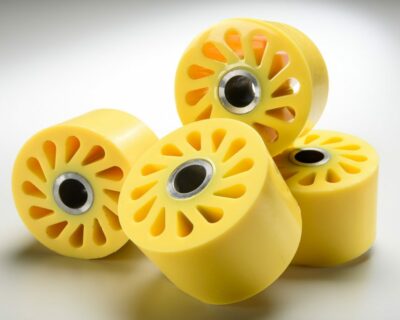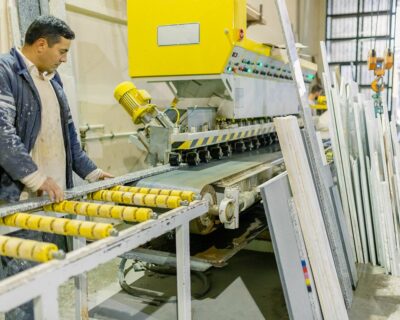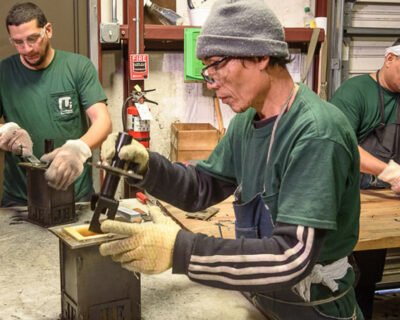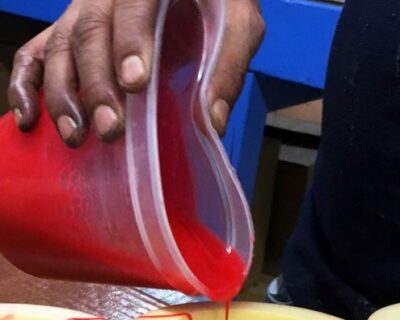An engineering company needed to reduce costs for specialty urethane parts used in the systems the company built for mining, agriculture and industrial applications. A supplier referred the engineering company to Urethane Innovators.
Challenge
The engineering company had been told one set of parts (red) were made from MDI (methylene diphenyl diisocyanate) urethane, and the other set of parts (blue) from a TDI (tolylene diisocyanate) formulation.
MDI urethanes generally run very true to color, so the color of the dispersion used as a pigment will be the same with each part.
With the engineering company’s parts, however, some of the red parts had a yellow tint, which indicated they might not be a true MDI formulation – and thus not perform as intended in the field. Additionally, the part supplier had been swapping the MDI and TDI materials back and forth.
The UI production team could see, just by looking at the parts, the engineering company wasn’t getting what they had been told they were paying for.
Solution / Implementation
Based on this observation and other tests, UI made a number of recommendations for reducing the engineering company’s manufacturing costs for the parts.
Recommendation #1: Test new formulations
The customer wanted to maintain the two formulations. To help reduce their costs, UI recommended better selections based on physical properties, process ease, and material cost.
For the engineering company, wear life is tantamount due to the abrasive conditions in which their systems are installed, so they were concerned a new formulation would reduce the life of the parts.
Rather than make a full production run using the new formulation, UI made sample parts for the engineering company to test. According to the company’s Applications Engineer, the new formulation was equal to the old one with regard to part life – but now at less cost.
“UI asked us a lot of questions about our parts, the additives used in the formulations, and where and how the parts were used. They were very quick to understand what we needed,” says the Application Engineer, “and then made recommendations.”
Recommendation #2: Eliminate a step in the manufacturing process
Some of the urethane parts included a metal insert – which bonds to the urethane. Based on supplied drawings and information from the Applications Engineer, the UI team discovered the manufacturing process included an unnecessary step with regard to ensuring the bond between metal and urethane.
UI eliminated this step – which reduced costs further still.
Recommendation #3: Create “soft” molds
The urethane parts from the original supplier were cast in aluminum molds, which is an excellent mold material, until it gets nicked or scratched. The nick or scratch must then be massaged to make it less noticeable, but after a certain number of blemishes, a new mold must be created, which can become costly over time.
UI recommended soft tooling – that is, molds made from urethane. Soft tooling allows UI to make multiple tools from a single aluminum master, which meant that UI was able to reduce tooling costs as well as manufacturing down time.
Recommendation #4: Improve part quality
UI also worked to improve the visual quality of the parts – with edges, surfaces, and lettering much cleaner.
Results: Reduced part costs without a reduction in wear life
“Urethane Innovators sent us sample parts, and based on our feedback, would make tweaks and adjustments,” says the Application Engineer. “This back and forth did take some time, but the end result was worth it.”
According to the Engineer, all parts shipped met the company’s specifications. By using a blanket order system, the customer was able to schedule releases. This system allowed UI to manufacture parts in a single production run instead of several runs of smaller quantities — thus help lower costs.
Most importantly, wear life has not been affected – and costs have been significantly reduced.
“My colleague and I visited the UI facility,” sums up the Engineer, “where we were treated to true southern hospitality by the UI team. During our visit, it was very clear that UI is a family-owned company that cares about their employees and customers.”
Finding ways to reduce costs for the engineering company also helped UI; the production team examined its own processes and found areas where they could improve output and quality.
Finding solutions to industrial challenges using urethane is what UI does best – but sometimes, the “solution” is simply excellent customer service. Whether you need to reduce costs, as with this engineering company, or you want your parts shipped out on time, every time, we get the job done. It’s why companies across the US rely on Urethane Innovators for their critical urethane parts needs.








